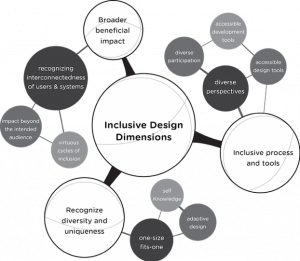After reading flexible learning for open education I thought it was very helpful and heartwarming to see the first discovery tool it helps recognize different ways that someone learns
One of the first points was called recognizing diversity and uniqueness and showed me that there are there is work being done on understanding the vast ways in which students/people learn! For example, in point one it states: Of the three dimensions of inclusion to design recognize diversity and unique uniqueness stresses that flexible or adaptive systems are key. Furthermore, It mentions some separate solutions are not sustainable economically or technically so just doesn’t necessarily imply that adaptive systems help the user make choices but the inclusive design will highlight the critical aspect being autonomous whilst seeking knowledge. In other words, user friendly & adaptable.
The second point around three dimensions of inclusive design where increases processing tools so this stated The dynamic of the learning resource is applicable and not discriminatory so if someone has a disability then not only does the resource not Pander to participants and treat them like tokens rather this tool is useable and only possible because it is inclusive, and accessible.
The third point is about broader beneficial impact so there’s a responsibility here that designers must understand That they have the ability to reach larger demographics, because these three dimensions support the intellectual well-being of society and encourages dynamic
I attached a figure for a visual representation of inclusive designs:

From the inclusive design research centre 2020
I experienced difficulty/confusion around universal design. Initially, I did not know that universal design and inclusive design were different and because universal design to me sounded like a form diverse learning amongst a multitude of backgrounds and required needs. This was not the case. As inclusive design research centre states over three main distinguishable facts about the differences between inclusive design and universal design: The Context, The User, and the Method. Universal design often times categorizes design advice according to constrained categories of disability, (IDRC, 2020). What seems apparent here is that inclusive design focuses on various forms of integrated learning whether or not one has a disability. It is adaptable.
As a side project I run community discussions for marginalized demographics. It requires active participation from those in attendance. An example of a session I facilitated was about accessibility in dance. Those communicating were individuals who experienced physical/mental/hidden barriers in dance and the arts. To make sure their messages was experienced by everyone in the room, there were two sign language interpreters, a dictation tool that projected words spoken on a big screen. As well as audio (speakers/mics), in addition to personal scribes, folks scattered around the room to help individuals take notes to pass up to the participants speaking. When I saw this topic, it made me think of my work in the community. And how quickly I learned that to be inclusive, even in a communal conversation, means that language needs to be accessible for everyone in its various forms. Currently, I am having to shift the way I run my sessions, to a virtual setting using Zoom. My personal obstacle will be creating accessibility for my community that join my Table Talk sessions.
I guess my question is simple, is “Universal design” outdated?
By Parker Johnson
References
Idrc.ocadu.ca. 2020. Inclusive Design Research Centre. [online] Available at: <https://idrc.ocadu.ca/index.php/resources/idrc-online/library-of-papers/443-whatisinclusivedesign> [Accessed 23 March 2020].